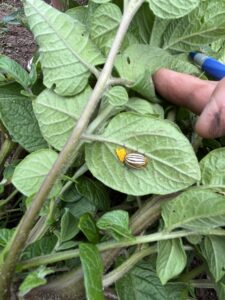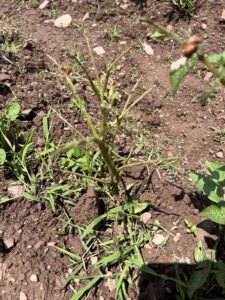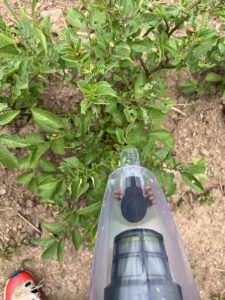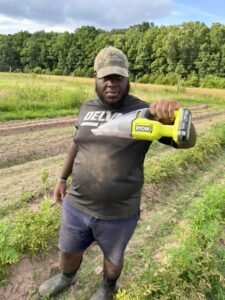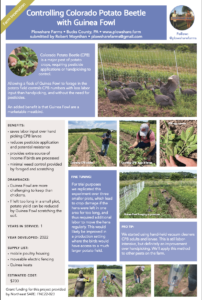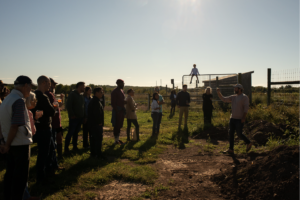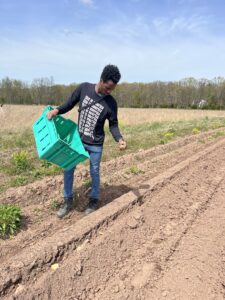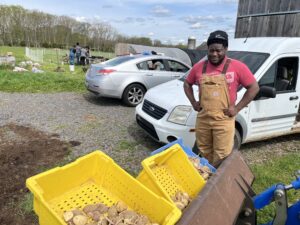Final report for FNE22-023
Project Information
The Colorado potato beetle (CPB), Leptinotarsa decemlineata (Coleoptera: Chrysomelidae), is a significant insect pest of potatoes in the Northern Hemisphere. Both adult and larval instars feed exclusively on solanaceous crops and weeds, causing significant damage to potatoes and eggplants. It is difficult to control using both conventional and organic chemicals and is legendary for its capacity to develop insecticide resistance. Plowshare Farms, in coordination with Bucks County Foodshed Alliance and collaborators, conducted research trials to evaluate the economic and agronomic impacts of two organic pest control solutions: 1) hand picking including using handheld cordless vaccums and 2) guinea fowl.
Data showed that the use of guinea fowl as a cultural control of CPB is equally as effective as using handheld vacuums to manually remove the pests. While the use of guinea fowl may lead to slightly lower pest counts and defoliation percentage, one must also consider the time investment and the potential for the guineas to damage crops by knocking down foliage and scratching tubers. Results were shared through on-farm demonstrations and a presentation at the PASA conference.
This project seeks to (1) evaluate the effectiveness of innovative organic pest control methods (2) determine the economic viability of treatments, and (3) clearly communicate results to farmers.
PROBLEM:
The Colorado potato beetle (CPB), Leptinotarsa decemlineata (Coleoptera: Chrysomelidae), is a significant insect pest of potatoes and is a major pest within the Northern Hemisphere (Sporleder, 2013). Both adult and larval instars feed exclusively on solanaceous crops and weeds, causing significant damage to potatoes and eggplants (Penn State Extension, 2017). It is also extremely difficult to control using both conventional and organic chemical (Alyokhin, 2009). Colorado potato beetle is legendary for its capacity to develop insecticide resistance (Forgash, 1981). Colorado potato beetle has developed resistance to all major classes of synthetic insecticidal classes, including the neonicotinoid imidacloprid. To combat resistance, conventional growers alternate insecticides in a 1–3 year rotation but “for organic growers, there are fewer products available, and cultural control practices should be followed to avoid dependency on a product” (Hazzard, 2021). One cultural control widely used by organic and chemical-free farmers is removing CPB adults and larvae by hand. This method is effective, but can constitute a significant labor expense.
PROPOSED SOLUTION:
Plowshare Farms, in coordination with Bucks County Foodshed Alliance and collaborators, will conduct an on-farm research trial evaluating the economic and agronomic impacts of two organic pest control solutions:
- TREATMENT 1 Hand Picking: To improve by-hand removal of CPB adults and larvae, farmers will use handheld, cordless vacuums.
- TREATMENT 2 Guineafowl: Organic growers have long used guineafowl as a method of biological pest control, reaping the benefits of the guineafowl’s voracious appetite for insects and arachnids. Guineafowl will be effective at removing Colorado potato beetles, and may be less detrimental to flying beneficial insects than DE. Guineafowl will be hatched on a schedule such that they will reach maturity before the emergence of the first-generation CPB adults in early May, and can be processed for meat production after the emergence of second-generation CPB “summer adults.” By processing the guineas after the CPB season, the flock can pay for itself, covering the cost of the pest control, as well as feed for the young guineas.
Plowshare Farms has been in business for 9 years, raising produce, lamb, pork, and chickens on approximately 20 acres in a given season. I have farmed full time for 7 seasons, and since the COVID-19 pandemic I devoted more time to parenting and small off-farm jobs. Gross sales of the farm are generally in the range of $40-85,000.
Cooperators
- - Technical Advisor (Researcher)
Research
This experiment measured Colorado Potato Beetle(CPB) populations, defoliation of potato plants, and potato yield, and how these variables were affected by the presence of Guineafowl vs. the more traditional cultural control of removing pests by hand. Guineafowl were allowed free access to segregated potato fields for 1-2 weeks at a time. To improve handpicking of pests, cordless handheld vacuums were used to remove CPB larvae and adults. To measure relative effectiveness of each method, we performed regular counts of CPB egg masses, small larvae, large larvae, adults, and defoliation of plants. We used the UMass Extension Potato Scouting Form to record data. The experiment was conducted with two potato varieties (Banana Fingerling and Red Norland) and was conducted across 3 replication plots to control for variability in soil type and cultural variations.
Guineafowl were segregated from handpick/vacuum plots using temporary electric mesh fencing, which along with mobile housing was moved to each replication plot at 1-2 week intervals. The moving of guineafowl and their fencing was determined to be an added time expense over handpicking/vacuuming.
Initially guineafowl were left on the first research plot for 2 weeks, but their excessive scratching and foraging caused minimal to moderate damage to the potato plants. After this, guineafowl were moved weekly.
Potatoes were not irrigated, as it was reasoned that rainfall would be more consistent across replication plots than irrigation due to the plots placement around the farm. The 2022 growing season was unusually dry at key growing periods, and this is believed to have negatively affected yields.
Pest numbers, defoliation percentage, and yields were somewhat mixed across potato varieties and replication plots, showing no clear winner between the two treatment methods. The data indicate that guinea fowl were equally as effective as handpicking with vacuums. The use of handheld vacuums was surprisingly effective at removing CPB adults and larvae and keeping them contained without the use of a bucket of soapy water. Emptying the vacuums in the chicken coop was an easy and effective way to make use of the pests.
2023 Farm Innovations - Plowshare
Plot A
| DATE | A | A | A | A | ||
| Norland | Norland | Fingerling | Fingerling | |||
| Guinea | Hand-Pick | Guinea | Hand-Pick | |||
| AVG. | ||||||
| 1 | 6/13/22 | Egg Mass | 0.04 | 0.04 | 0.23 | 0 |
| Small Larvae | 0.74 | 1.85 | 1.41 | 1.37 | ||
| Large Larvae | 2.67 | 2.35 | 3.36 | 0.05 | ||
| Adult | 0 | 0.08 | 0 | 0.18 | ||
| % Defoliation | 2.6 | 0.96 | 4.32 | 0.53 | ||
| 2 | 6/21/22 | Egg Mass | 0 | 0 | 0 | 0.18 |
| Small Larvae | 0.11 | 0 | 1.67 | 1.41 | ||
| Large Larvae | 0.25 | 0.55 | 0.91 | 0.24 | ||
| Adult | 0 | 0 | 0 | 0 | ||
| % Defoliation | 10.89 | 6.55 | 4.76 | 3.82 | ||
| 3 | 6/28/22 | Egg Mass | 0 | 0 | 0 | 0 |
| Small Larvae | 3.08 | 2.67 | 1.22 | 0.91 | ||
| Large Larvae | 0.75 | 0.07 | 1.26 | 3.67 | ||
| Adult | 0 | 0 | 0 | 0.05 | ||
| % Defoliation | 17.21 | 7.85 | 4.52 | 3.29 | ||
| 4 | 7/6/22 | Egg Mass | 0 | 0 | 0 | 0 |
| Small Larvae | 0 | 0 | 1.65 | 0 | ||
| Large Larvae | 0.07 | 0.15 | 0.15 | 5.94 | ||
| Adult | 0.37 | 0.52 | 1.2 | 0.56 | ||
| % Defoliation | 12.96 | 8.89 | 4.75 | 8.13 | ||
| avg defoliation | 13.68666667 | 7.763333333 | 4.676666667 | 5.08 | ||
| Yield | 16.9 | 53 | 12.2 | 11.3 |
Plot B
| B | B | B | B | |||
| Norland | Norland | Fingerling | Fingerling | |||
| Guinea | Hand-Pick | Guinea | Hand-Pick | |||
| 1 | 6/14/22 | Egg Mass | 0.07 | 0 | 0.1 | 0.05 |
| Small Larvae | 0.59 | 1.2 | 3.75 | 3.3 | ||
| Large Larvae | 0.45 | 1.75 | 0 | 0.9 | ||
| Adult | 0.1 | 0 | 0 | 0 | ||
| % Defoliation | 2.76 | 4.12 | 0.5 | 1.5 | ||
| 2 | 6/24/22 | Egg Mass | 0.04 | 0.04 | 0.05 | 0.29 |
| Small Larvae | 0.42 | 0.35 | 0.18 | 0.1 | ||
| Large Larvae | 0.81 | 0.69 | 0.59 | 1 | ||
| Adult | 0.15 | 0 | 0.05 | 0.1 | ||
| % Defoliation | 7.31 | 10.77 | 5.91 | 6.43 | ||
| 3 | 7/8/22 | Egg Mass | 0.04 | 0 | 0.05 | 0 |
| Small Larvae | 0 | 0 | 0 | 0.28 | ||
| Large Larvae | 0 | 0 | 0 | 1.39 | ||
| Adult | 0.07 | 0 | 0.71 | 0.61 | ||
| % Defoliation | 3.75 | 12.12 | 2.62 | 6.39 | ||
| avg defoliation | 4.606666667 | 9.003333333 | 3.01 | 4.773333333 | ||
| Yield | 37.5 | 37.2 | 13.4 | 14.4 |
Plot C
| C | C | C | C | |||
| Norland | Norland | Fingerling | Fingerling | |||
| Guinea | Hand-Pick | Guinea | Hand-Pick | |||
| 1 | 6/15/22 | Egg Mass | 0.12 | 0.08 | 0.17 | 0.09 |
| Small Larvae | 3.36 | 0.29 | 1.74 | 3.17 | ||
| Large Larvae | 1.04 | 0 | 0.49 | 1.87 | ||
| Adult | 0.12 | 0.08 | 0.13 | 0 | ||
| % Defoliation | 5.8 | 4.33 | 3.91 | 16.78 | ||
| 2 | 6/24/22 | Egg Mass | 0 | 0 | 0 | 0 |
| Small Larvae | 1.12 | 0 | 0.5 | 0 | ||
| Large Larvae | 0.76 | 0.74 | 0.82 | 1.1 | ||
| Adult | 0.04 | 0.43 | 0.09 | 0.05 | ||
| % Defoliation | 3.2 | 6.3 | 3.18 | 5.95 | ||
| 3 | 7/2/23 | Egg Mass | 0 | 0 | 0 | 0 |
| Small Larvae | 0 | 0 | 0 | 0.06 | ||
| Large Larvae | 0.04 | 1.05 | 0.05 | 0.39 | ||
| Adult | 0.09 | 0.23 | 0.6 | 1.5 | ||
| % Defoliation | 7.61 | 11.59 | 3.25 | 3.89 | ||
| avg defoliation | 5.536666667 | 7.406666667 | 3.446666667 | 8.873333333 | ||
| YIELD | 33.2 | 26 | 11.8 | 9 |
Analysis of our data indicates that the use of guinea fowl as a cultural control of Colorado Potato Beetle is equally as effective as using handheld vacuums to manually remove the pests. Use of guinea fowl may lead to slightly lower pest counts and defoliation percentage, but also constitutes a time investment and the potential for the guineas to damage crops by knocking down foliage and scratching tubers. We were not able to determine how much of the added time investment was due to moving the guinea fowl between replication plots for the sake of the experiment, or how much damage was caused because the guinea fowl were kept in a smaller segregation plot. That is, in practical application, a farmer would likely fence in their entire potato crop allowing guinea fowl free access to the field without the need to move more than once or twice throughout the growing season. If a farmer already had infrastructure for keeping poultry, guinea fowl could be added at little added expense, and if given access to potato fields could replace manual removal of Colorado Potato Beetles. One area of further study we would like to look into is if there are certain CPB lifecycle pinch points where cultural controls could be most effective. That is, could a well timed cultural control (guinea fowl or vacuuming) interrupt CPB lifecycle enough to significantly reduce 2nd and 3rd generation feeding later in the season.
Education & Outreach Activities and Participation Summary
Participation Summary:
We hosted 6 on-farm demonstrations, 2 field days, and 12 farm tours highlighting our use of guinea fowl to control Colorado Potato Beetle. These events have been aimed at community members, restaurant industry staff, educators, farmers, agriculture students and apprentices, researchers and plant breeders. Our on-farm demonstrations had approximately 15 participants, our field days and workshops had approximately 20 participants, and our farm tours had approximately 450 participants. We also presented our findings at the PASA conference, in the Farm Innovation section (2023-Farm-Innovations-Plowshare). The conference draws upwards of 2,000 attendees.
Learning Outcomes
Farmers who toured our farm and learned about our project reported an intention to incorporate use of handheld vacuums to control a number of different insect pests on their farms. Even those who were not ready to use guinea fowl or other poultry directly in their fields expressed interest in using handheld vacuums to remove CPBs, cucumber beetles, squash bugs, and other pests and feed the removed insects to their poultry flock. Roughly half of those farmers also expressed an intention to incorporate guinea fowl into their farm operations, for use in potato plantings, but also in orchard settings. Another area in which farmers reported a change in knowledge and attitude was surrounding the marketability of guinea fowl as meat. Farmers who primarily market their crops through CSA and farm stands were surprised to learn that guinea fowl was a prized and highly marketable meat bird among high end restaurants.
Project Outcomes
Since completing this project we have stopped raising guinea hens, because of the difficulty of keeping them in a specific area, and the higher losses of guineas due to flying over fences and finding ways to get out. We have however, started using laying hens and broiler chickens as pest control on potatoes. One finding in this study was that given time, guineas will scratch up the soil, to the detriment of root crops. We have used this knowledge to our benefit however, allowing our chickens to scratch around blackberry and raspberry brambles, as well as dense hedgerows like elderberry. The chickens clean up dropped fruit and reduce weed pressure with less labor input. Farmers who attended our tours have indicated that they will use guinea fowl in orchard settings to clean up dropped fruit and control various fruit tree pests.
Our control method of using handheld vacuums to control pests proved very effective, and this is a practice we will continue to use on various crops and pests. Farmers that attended tours of our farm, and a Pest Control workshop I presented indicated that they will incorporate handheld vacuums into their practices.
In addition to sharing our experience with guinea fowl and handheld vacuums, at each tour, dinner event, workshop, and field day we shared with other farmers our experience applying for a SARE grant and conducting on-farm research trials. We don't know how many farmers applied for or received grants, but nearly every farmer we spoke to had some on-farm innovation or novel farming practice that they had developed on their farm and were eager to test out in a more rigorous setting.
After working on this project, our collaborator, Dr. Sarah Dohle, invited us to join a grant funded project she is conducting in partnership with the USDA, University of Delaware, and UC Davis, conducting field trials and market research on various Lima bean varieties.
Our research clearly showed that guineafowl are an effective control of Colorado Potato Beetle. In terms of number of pests, defoliation, and yield, guineafowl proved to be as effective as manually removing CPB with handheld cordless vacuums. On the other hand, the management of guineafowl, particularly moving them from one treatment plot to another proved to be a much greater time investment than manually removing pests. Within the confines of this study, it was difficult to assess what the time investment would be if a farmer were using guineafowl in a real world scenario, without the need to move them at regular intervals, or keep them segregated on smaller research plots.
Due to the scope and timeframe of our study, we were not able to determine the marketability of guineafowl for meat production. Guineahen eggs were an added benefit this season, but in itself not worth the effort of raising them. We have had lots of interest in guineafowl from our restaurant customers, but we were not yet able to work out the timing to use them for CPB control and process immediately after.
We will likely continue to raise guineafowl and encourage other farmers to do so. They are voracious and efficient insect predators, and would be effective in a number of crops where food safety guidelines allow.
